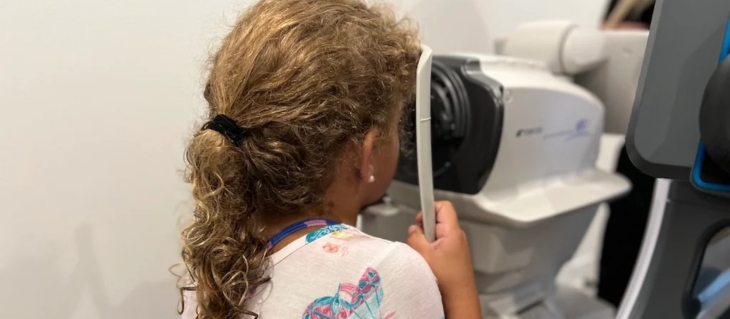Since working at Kapoor Eye Care, I have seen patients who come in and haven’t had an eye exam in over 10, 15, or even 20 years. This is a major problem because many diseases can develop with no symptoms, and when these diseases manifest they can be detrimental to a person’s eyesight.
For children, annual eye exams are crucial to diagnose amblyopia and myopia. Amblyopia, also known as “lazy eye”, occurs when one eye has normal vision and the other eye has poor vision. This imbalance causes the brain to essentially use the weaker eye less causing the weaker eye to have reduced vision. Untreated amblyopia can cause vision loss in the weaker eye, making an eye exam essential. Myopia, or nearsightedness, is when the eye grows abnormally in length or the cornea is too curved. This causes light rays to not focus directly on the retina, creating blurry vision. Myopia increases the risk of glaucoma, retinal detachment, cataracts, myopia maculopathy, and other vision problems that could lead to blindness. Besides amblyopia and myopia, eye exams are needed to help children do well in school. School vision screenings are not enough to diagnose diseases or find binocular vision issues that could have no early symptoms. The only way to make sure that your child’s eyes are normal and healthy is through a comprehensive eye exam.

Adults should get eye exams every 1-2 years or more depending on whether they have certain health conditions like diabetes. Diabetic eye exams are necessary to help diagnose and track early development of diseases like diabetic retinopathy, one of the leading causes of blindness in adults. Additionally, with more technology use, dry eye disease has increased exponentially in today’s society. One major cause of dry eye disease is meibomian gland dysfunction (MGD). The meibomian glands are located in the eyelids and secrete meibum, a type of oil that forms your tears to lubricate your eyes. MGD occurs when these meibomian glands don’t release the necessary oils to lubricate your eyes. This can be because of several reasons, including partial blinking when using technology. Although many patients experience symptoms of dry eye because of MGD, some don’t. According to Johnson and Johnson, “20% of MGD (meibomian gland dysfunction) patients may not have any dry eye symptoms.” Patients not experiencing dry eye symptoms will not know that treatment is necessary unless they get an eye exam. Both DMV vision checks and school vision screenings provide very basic vision information and check nothing related to the health of the eyes.
In short, regular comprehensive eye exams are necessary to check-up on your eye health. By using the newest technologies, Kapoor Eye Care is at the forefront of comprehensive eyecare. Call to schedule an appointment and check on your eye health today!
Sources
1. https://www.allaboutvision.com/eye-care/eye-exam/importance/
2. https://www.cdc.gov/vision-health/about-eye-disorders/why-eye-exams-are-important.html
3. https://www.aoa.org/healthy-eyes/eye-and-vision-conditions/myopia
4. https://www.clearvisionforyou.com/en-us/meibomian-gland-dysfunction/what-is-mgd/


